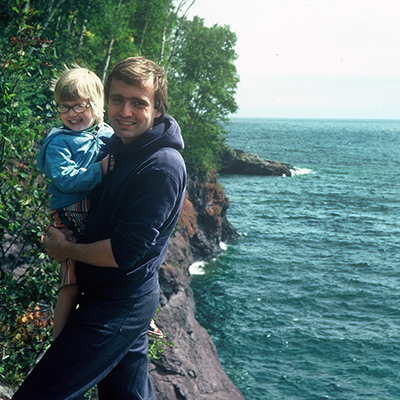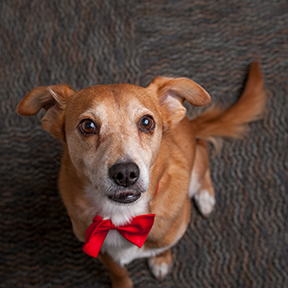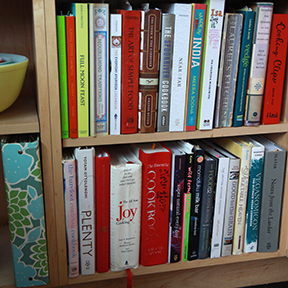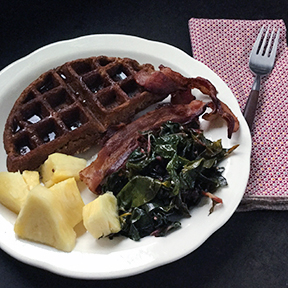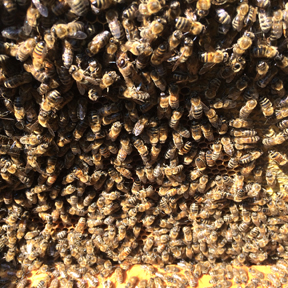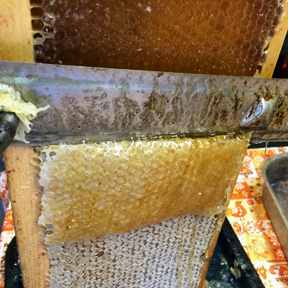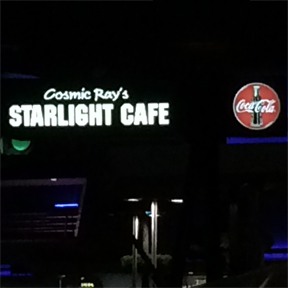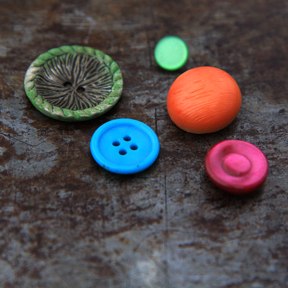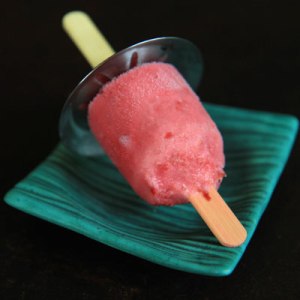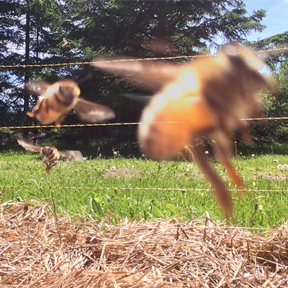It’s finally time. I’ve been avoiding writing about this like one puts off writing about death. But invariably it needs to be done, despite one’s lack of words to do it justice. And I should warn you, it’s going to be a doozy. We’ve got to go back to the beginning for this one. Brace yourself.

I got my first pair of glasses when I was three. I’m not exactly sure how my parents discovered this need, but once established, they dutifully toted me to the optometrist every year. And every year my vision got a little worse. I grew up hating my glasses. They were thick and brown and ugly. As I got older, I’d sometimes try for a more fashion forward frame, but even a mid-size frame doesn’t mingle well with my strong prescription. The larger the frames, the thicker the lenses—a fact I was desperate to disprove.
I began my campaign for contacts early and during the summer between fifth and sixth grade, I was deemed worthy to give them a go. And believe me, I took my contact lens wearing responsibility seriously. They were my golden ticket. They meant nobody need see me in my thick, ugly glasses ever again. I’ve maintained this strict, no glasses in public unless absolutely necessary policy my entire adult life. Until eight months ago.
We need to skip ahead here to the fact that I currently have only one correctable, contact lens wearing eye, and, at the time, it was suffering from a mild infection. Which meant no contact lens for a week. Not a big deal, except I had a party looming on the horizon. It was a 50th wedding anniversary—a celebration that felt a whole lot more like a reunion than a party. It involved people I grew up with and hadn’t seen in twenty years.
I begged my eye doctor to let me slip into my contact, just for a few hours. She acquiesced, but not before I began feeling a little vain and shallow. These are my people, I thought. They know me as shy the kid with dorky glasses, and they love me anyway. With a pang in my stomach, I dared myself to go to the party in my glasses.
And I did. And I felt incredibly self-conscious And yes, I know I was being ridiculous. Logic was no help. But it did prove to be a worthwhile experiment. I started challenging myself to wear my glasses out in public, by my own free will. It’s crazy, isn’t it? How fiercely we cling to our lifelong beliefs? Until someone or something comes along and politely pokes a finger in them. Whooboy. This is the work, sister.
But, as is often the case, this was just the tip of the iceberg.
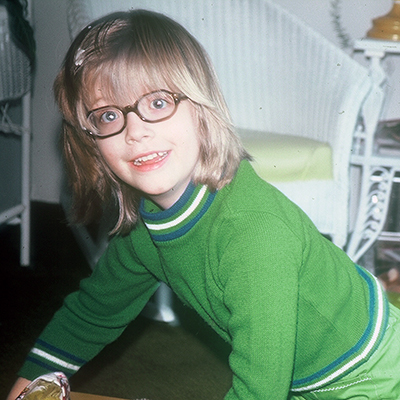
A few months later, I was driving home from work listening to Jess Lively whose guest was Jacob Liberman, author of Take Off Your Glasses and See. I didn’t get very far into the interview, but far enough to remind me that my dad had given me a couple of similar books years ago—Aldous Huxley’s The Art of Seeing and Seeing Without Glasses by Robert-Michael Kaplan. They’ve been on my shelf for seventeen years. Untouched. I have a small house. I dislike clutter. Untouched things do not last seventeen years. I have no idea what made me keep these books. Perhaps it was out of nostalgia over his death a few years later. Or maybe it was because of our shared bond of bad eyesight. But most likely, I just wasn’t ready yet.
That night I thumbed through the books and re-read the letter my dad had sent along with them. He encouraged me to try the prescribed eye exercises and assured me that either way the books were filled with valuable life advice. In closing he wrote “Perhaps you will better understand why your particular eyes can be thought of as a gift.” I remember thanking him for the books, but secretly I was thinking, yes, yes, this may be interesting and enlightening, but it’s not for me. My eyes are too far gone. Oh how very wrong I was.
I finished up the podcast with Dr. Liberman and resonated so deeply with him that I ordered his book. While I waited for it to arrive I devoured the two from my dad. I’ve always chalked up my bad eyesight to pure genetics. But these authors were offering up a new theory for me to consider—that our vision declines due to environmental interactions, some external stressor. This could be a physical strain, like staring at a screen, or (and more likely) it could be emotional, some fear or discomfort that we don’t know how to process. Regardless of the source, our body’s solution is to create some distance between ourself and the perceived stressor. And how better to do this than by putting a slight blur on the world. Let’s just soften things up a tad, make our reality not quite so harsh.
Not a bad safety mechanism really. The problem, of course, is that the standard response to our body’s innovative response is to slap on a pair of corrective lenses. Ideally ones that bump us right back up to 20/20 vision. Which, if you buy into the theory, puts the strain we were so comfortably backing away from, full strength in front of us again. Okay, say the eyes, no big deal, we’ll just gradually blur things up again. An approach that works wonders on our subconscious, until the next visit to the optometrist, who dutifully sends us off with a slightly stronger prescription. I’m glossing over the mechanics of it, but are you seeing the pattern here?

In four decades of eye doctor visits, I have never thought of my eyes as anything but “bad.” They are something to correct. Something to fix. This is so engrained in me that it has never once, even remotely occurred to me that my eyes are fine. That they might just be trying to tell me something.
I’m sure the majority of optometrists would scoff at this theory (let alone the belief that we can gradually reverse our vision through a variety of exercises and techniques). And I don’t begrudge them, or the vision they’ve afforded me over the years. But science aside, I can tell you this. I spent the majority of my childhood (and even my adult life to some extent) trying to become invisible. Saying I was shy doesn’t do it justice. I had a normal, happy childhood. I was an engaged, albeit quiet, kid. But that didn’t alleviate a deep down desire to always want to back away, to quietly disappear. I did this without awareness, it’s just how I operated. It’s only now that I can recognize it and start to bring some understanding to it.
And interestingly enough, in my late twenties, when my nearsightedness couldn’t get much worse, a whole new string of eye issues started unfolding for me. I was plagued with a virus that led me down a slippery slope of chronic inflammation, a cornea with a scar that’s been likened to the Grand Canyon, a dense cataract, and glaucoma (remember when we fast forwarded to me having only one correctable, contact lens wearing eye?) Naturally, these events have further perpetuated my “bad eye” belief.
I’ve never intentionally done any activity without wearing my glasses or contact (which, despite their titles, isn’t actually what these books are suggesting). But this past fall, I started taking walks with my eyes, just as they are. One with a -15.75 correction and the other that can perceive light and close up motion. And I was stunned. Things were no longer blurry. Instead, they appeared exactly how my eyes wanted to take them in. My vision wasn’t good or bad. It just was. You may be thinking, yeah, so? But turning a lifetime of bad eyesight into perfect eyesight, was nothing short of mind blowing. The color was amazing. The dimensionality was amazing. The light was amazing. I think I cried on at least a dozen walks.
I was so moved by my discovery that I started trying other things with my eyes, just as they are. I can read with a book held an inch in front of my face. And at that distance, I can see the fibers that make up the paper, the pixels that turn into letters, and the well thought out detail of each serif. It’s a surprisingly gorgeous experience. I can cook in the kitchen and it requires me to be much less precise and far from perfect. Two traits I’ve had a lifelong struggle with. Coincidence? Ha. Hardly.
Not wearing my glasses or contact tends to rule out a lot of activities. But here’s the thing, when I use my eyes just as they are, my world is a softer, quieter place. There are no hard edges. I move deliberately. My brain steadies, stops it’s relentless spinning. I see more beauty and fewer problems—which leaves way less room for judgment. But the second I slip my glasses or contact on, it all goes away. The sharpness and clarity that my prescription provides can feel like a slap in the face.
I don’t mean to sound ungrateful. I am entirely appreciative of the doctors, technologies, and surgeries that have given me the ability to see and lead my own unique life. I wouldn’t trade it for any other. But this new and growing understanding of my eyes has struck a chord so deep and so rich that it’s hard to articulate. It turns out my father was right. My particular eyes and all they’ve been through, are, indeed, a gift. I can’t wait to see where they take me.
